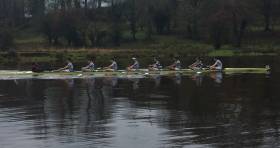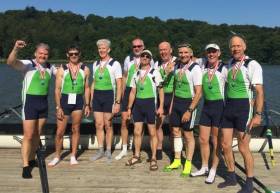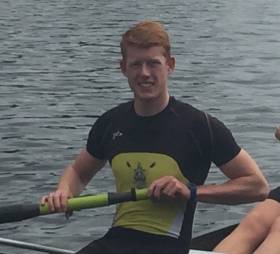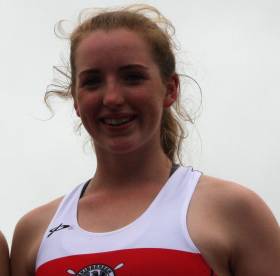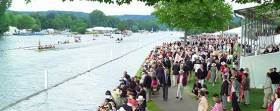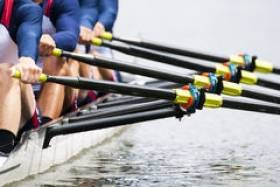Displaying items by tag: commercial
UCD The Top Eight at Skibbereen Regatta
#Rowing: UCD won the men’s senior eights at Skibbereen Regatta today. They led Commercial with 500 metres to go and the Irish champions could not head the men in blue and saffron. The senior women’s eight was won by a Skibbereen/UCC composite which drove away from their opponents impressively over the final 100 metres.
Skibbereen Grand League Regatta, National Rowing Centre (Selected Results; with Per Centage of Projected World Gold Medal Winning Time)
Sunday
Men
Eight – Div One – A Final: 1 UCD (sen) 5:44.4 (92.62), 2 Commercial (sen) 5:46.3 (92.13), 3 UCD (inter) 5:54.9 (89.9); 5 Enniskillen (jun 18A) 6:00.6 (88.46). B Final: 2 St Michael’s (club one) 6:04.3 (87.57). Four - Div One – A Final: 1 Commercial (sen) 6:16.1 (90.40), 2 NUIG (sen) 6:25.1 (88.28), 3 Commercial B (sen) 6:26.9 (87.89). Div Two (coxed) – A Final: 1 Queen’s A (club two) 6:50.5; 5 Shandon (jun 16). B Final: 1 Commercial (jun 18B) 7:06.6.
Sculling,
Quadruple – Div Two, coxed – A Final: 1 Carlow (jun 18B) 6:52.4, 2 Shandon A (jun 16) 6:54.4, 3 Lee (club two) 6:56.5; 6 Queen’s (nov) 7:11.6.
Double – Div One – A Final: 1 Skibbereen, UCD (G O’Donovan, P O’Donovan; sen) 6:27.8 (92.83), 2 Skibbereen (M O’Donovan, S O’Driscoll; sen) 6:29.4 (92.64), 3 Skibbereen B (sen) 6:31.4 (91.98). B Final: 1 Shandon (inter) 6:42.3 (89.48); 3 Shandon A (jun 18A) 6:53.0 (88.03). C Final: 5 Carlow (club one) 7:01.4 (85.42).
Single - Div Two – A Final: 1 Shandon (J Dorney; jun 16) 7:34.6, 2 Cork (C O’Sullivan; jun 18B) 7:41.1, 3 UCC (J Larkin; club two) 7:48.2.
Women
Eight – Div One – A Final: 1 Skibbereen/UCC (sen) 6:32.3 (89.97), 2 NUIG (inter) 6:36.6 (89.01), 3 Commercial (sen) 6:41.3 (87.96); 5 Cork BC (club one) 6:50.9 (85.92); 6 Col Iognaid (jun 18A) 7:10.4 (82.01).
Four – Div One – A Final: 1 UCD (sen) 7:07.1 (88.04), 2 Skibbereen A (sen) 7:13.4 (86.75), 3 Commercial A (sen) 7:17.4 (85.96); 5 Enniskillen (jun 18A) 7:18.9 (85.67). Div Two, coxed – A Final: 1 Skibbereen (club two) 7:34.3; 6 Col Iognaid (jun 16) 8:06.6. B Final: 2 Shandon (jun 18B) 8:31.0.
Sculling
Double – Div One – A Final: 1 Old Collegians, Cambridge (S Puspure, C Lambe; sen) 7:09.7 (92.40), 2 Lee, Skibbereen (sen) 7:26.6 (88.90) 3 Neptune (inter) 7:42.2 (85.9), 4 Workmans B (jun 18A) 7:42.5 (85.84). B Final: 3 St Michael’s (club one) 7:56.1 (83.39).
Single – Div Two – A Final: 1 Lee Valley (E O’Mahony; club two) 8:22.3, 2 Lee Valley (E Buckley; jun 18B) 8:28.6; 5 Neptune (N Clarke; jun 16) 8:46.1
London Head Cancellation Hits Irish Crews Hard
#Rowing: The Eights Head of the River in London, which was set to take place tomorrow (Saturday) has been cancelled. In the a statement, the organisers said: “The Committee have been monitoring the weather forecast over the last few days and due to the strength and direction of the wind and in light of the difficulties encountered at yesterday’s Schools Head, we have reluctantly taken the decision to cancel this year’s race on the safety grounds.
“We recognise and understand the disappointment that this will cause for all competitors and others due to be involved in the race, however safety simply must come first.”
Ireland would have been strongly represented at the event, with Commercial, UCD, Trinity and Neptune all entered. A big number of rowers were already in London or travelling when the announcement was made.
O'Brien and Lambe in Cambridge Boat Race Squad
#Rowing: Claire Lambe and Sally O’Brien have been named in the Cambridge University women’s squad for the Boat Races. Lambe, who started rowing with Commercial, has represented UCD and Old Collegians. She competed for Ireland at the 2016 Olympic Games, partnering Sinéad Lynch in a lightweight double which reached the A Final. Sally O’Brien, who started rowing in Neptune, competed for Trinity and was captain of Dublin University Boat Club in 2014/2015. She played Gaelic Football at underage level.
The men’s and women’s Boat Races are on April 2nd. The chief coach of Cambridge University Women’s Boat Club is Rob Baker, the former Ireland under-23 coach.
Irish Masters Eight are Afloat Rowers of Month
#Rowing: The Irish eight which won at the World Masters Regatta at Lake Bagsvaerd, Denmark, have been chosen as the Afloat Rowers of the Month for September. There were a number of good results by Irish crews at the event, which is one of the biggest international events of the year. Among the competitors this year was Denmark legend Eskild Ebbesen. The Irish E eight (55 years or older), was drawn from five clubs (Commercial, Belfast Boat Club, Neptune, Old Collegians and Waterford Boat Club) and outpaced German and British rivals in a field of seven crews. They had also won last year at this level. The crew was: John Hudson, Denis Crowley, Gerry Murphy, Mick Heavey, Colin Dickson, Colin Hunter, Fran O’Toole, Donal Mc Guinness and cox Al Penkert.
Rower of the Month awards: The judging panel is made up of Liam Gorman, rowing correspondent of The Irish Times, and David O'Brien, editor of Afloat magazine. Monthly awards for achievements during the year will appear on afloat.ie and the overall national award will be presented to the person or crew who, in the judges' opinion, achieved the most notable results in, or made the most significant contribution to rowing during 2016. Keep a monthly eye on progress and watch our 2016 champions list grow.
Commercial the Senior Eights Rowing Champions of Ireland
#Rowing: Commercial won the senior eights championship of Ireland (the 'Big Pot') in a race with a thrilling finish at the Irish Rowing Championships. The Dublin crew took over the lead at halfway, but could not shake off UCD. In the final 250 metres, UCD charged and seemed set to catch Commercial, but the eventual winners found something and surged. The margin in an extremely fast race - Commercial recorded a time of five minutes 36.892 seconds - was less than a third of a second.
Skibbereen, in combination with UCC, won the women's senior eight. This was a much more emphatic win, with UCD challenging but not able to catch the winners. Skibbereen added the women's junior quadruple and the men's intermediate double titles to take their overall tally for the Championships to 13 - they now have 163 in total, 11 clear of nearest rivals, Neptune (152).
Marie Piggott of NUIG was a very clear winner of the women's intermediate single. Commercial were also in charge in their win in the men's junior pair.
Cork completed a good set of results for them when they won the women's club eight.
Irish Rowing Championships, National Rowing Centre, Day Three (Selected Results, Finals)
Men
Eights - Senior: 1 Commercial (D Joyce, M Maher, R Peguet, S Mac Eoin, F Groome, D Burke, C Dowling, N Gahan; cox: M Crockett) 5:36.892, 2 UCD A 5:37.220, 3 NUIG 5:44.377. Four - Club, coxed: NUIG 6:33.156.
Pair - Inter: Portora 6:49.900. Junior: 1 Commercial 7:00.686, 2 Portora B 7:02.186, 3 Portora A 7:03.905.
Sculling, Double - Inter: Skibbereen 6:33.887. Junior: 1 Shandon A 6:36.777, 2 Clonmel 6:39.324, Castleconnell A 6:51.168.
Lightweight Single: 1 Skibbrereen (S O'Driscoll) 7:15.482, 2 Skibbereen (A Burns) 9:08.433, 3 Carlow (O Nolan) 7:36.764.
Women
Eight- Senior: 1 Skibbereen/UCC (L Murphy, N Casey, O Hayes, C J Hearne, N O'Mahony, A Feeley, A Keogh, D Walsh; cox R O'Leary) 6:24.548, 2 UCD 6:29.778, 3 Trinity 6:40.377. Club: Cork 6:39.339.
Four - Inter, coxed: Commercial 7:20.348.
Pair - Junior: 1 Cork 7:35.640, 2 Bann 7:41.453, 3 Shannon 7:41.750
Sculling - Quadruple - Junior: 1 Skibbereen 6:46.308, 2 Bann 6:53.292, 3 Lee 6:59.527.
Single - Inter: NUIG (M Piggott) 7:58.822.
Lightweight Single: Skibbereen (D Walsh) 7:54.535, 2 Carlow (A Byrne) 8:21.130, 3 Queen's (R Brown) 8:33.287.
#Rowing: Skibbereen brought their tally of titles for the Irish Rowing Championships to a remarkable 10 so far as Denise Walsh and Shane O'Driscoll had big wins in the lightweight single sculls in the morning session of the third day.
Shandon's win in the men's junior double was a sweet one for Stephen O'Sullivan and Ronan Byrne. They led Clonmel all down the course and held off push after push in the final 500 metres. Strokeman O'Sullivan shouted with joy at the finish, but it was a particularly big win for Byrne. He had been beaten by the Clonmel strokeman, Daire Lynch, in the junior single. Byrne and Lynch team up in the Ireland junior double for the World Championships.
Cork Boat Club's good run in junior events continued, as Amy Mason and Tara Hanlon won the junior pair. Portora won the men's intermediate pair and NUIG the club coxed four. Commercial led all the way in the women's intermediate four and had a clearwater margin at the finish.
Irish Rowing Championships, National Rowing Centre, Day Three (Selected Results, Finals)
Men
Four - Club, coxed: NUIG 6:33.156.
Pair - Inter: Portora 6:49.900.
Sculling, Double - Junior: 1 Shandon A 6:36.777, 2 Clonmel 6:39.324, Castleconnell A 6:51.168.
Lightweight Single: 1 Skibbrereen (S O'Driscoll) 7:15.482, 2 Skibbereen (A Burns) 9:08.433, 3 Carlow (O Nolan) 7:36.764.
Women
Four - Inter, coxed: Commercial 7:20.348.
Pair - Junior: 1 Cork 7:35.640, 2 Bann 7:41.453, 3 Shannon 7:41.750
Sculling - Lightweight Single: Skibbereen (D Walsh) 7:54.535, 2 Carlow (A Byrne) 8:21.130, 3 Queen's (R Brown) 8:33.287.
Cork Four Beat Portora at Irish Rowing Championships
#Rowing: Cork Boat Club won the men's junior 18 coxed four at the National Rowing Championships today. On Friday, Portora had beaten Cork in the junior eight by leading all the way, but Cork turned the tables - they took the lead early and won by over six seconds. Daire Lynch, who won the junior single on the first day, added the club title with an emphatic win.
Emily Hegarty took the junior women's single by a huge margin, and her Skibbereen clubmates, Mark O'Donovan and Shane O'Driscoll, augmented the club's growing honour list by taking the men's senior pair. Their main rivals, UCD's Shane Mulvaney and David O'Malley, were over three seconds behind at the finish.
Commercial had a stirring win in the men's intermediate eight. UCD led to half way, just holding off Commercial, and it looked like there might be a battle between the two crews from there. But Commercial, stroked by Neil Gahan, moved away and won well in an excellent time.
In the women's novice eight Trinity won well, and Lee were commanding in their victory in the women's intermediate double.
Irish Rowing Championships, National Rowing Centre, Cork
Day Two (Selected results)
Men
Eight - Intermediate: Commercial 5:43.182.
Four - Junior, coxed: 1 Cork A 6:29.20, 2 Portora 6:35.341, 3 Clonmel 6:40.716.
Pair - Senior: 1 Skibbereen 6:30.311, 2 UCD 6:33.546, 3 Portora 6:44.968.
Sculling
Single - Club: Clonmel (D Lynch) 7:15.463.
Women
Eight - Novice: Trinity 7:09.594.
Sculling, Double - Inter: Lee 7:22.252.
Single - Junior: 1 Skibbereen (E Hegarty) 8:05.674, 2 Neptune (C Feerick) 8:13.065, 3 Castleconnell (J Vascotto) 8:15.002.
Ireland Crews Struggle at Henley Royal Regatta
#Rowing: On the first day of Henley Royal Regatta, Ireland’s three crews fell to opposition which made good starts.
UCD’s senior eight were beaten by Drexel University of Philadelphia in the Temple Cup for student eights. Drexel carved out an early lead, but UCD came back were in real contention to about halfway, when the Americans moved away to a clearwater lead, which they held to the end.
In the Thames Cup for club eights, Commercial fell to a young Dutch composite which made light of the difficult conditions of choppy water and a headwind. They started brilliantly, held off a push by Commercial and won well.
Lady Elizabeth, rowing in the Wyfold for club fours, veered off course early and hit the booms. While they recovered, there was no real prospect of catching leaders Tideway Scullers.
Henley Royal Regatta (Selected Results; Irish interest)
Temple (Eights, Student): Drexel University, USA bt UCD 2 ¼ l, 7:23
Thames (Eights, Club): Roeivereeniging Willem III, the Netherlands bt Commercial 3¾ l, 7:13.
Wyfold (Four, Club): The Tideway Scullers’ School A bt Lady Elizabeth easily; 8:05.
Lightweight Quadruple Again Shows its Class
#Rowing: Young, ambitious, crews impressed in the second set of finals at Cork Regatta at the National Rowing Centre. The Ireland under-23 lightweight quadruple were outstanding in their win - setting a time of six minutes 4.37 seconds - and the prospective women's Coupe de la Jeunesse quadruple also had plenty to spare in their victory.
UCD's men and Commercial's women won the division one coxed fours. Skibbereen, with a mix of experienced and younger oarswomen, won the division two eight.
Cork Regatta (Coillte Grand League), National Rowing Centre, Day One
Men
Eight - Div Two - A Final: 1 UCD (Club 2) 6:10.51; 3 Neptune (jun 18B) 6:26.949; 5 UCD (nov) 6:35.449; 6 Shandon (jun 16) 6:36.01.
Four, coxed - Div One - A Final: 1 UCD (inter) 6:35.94; 3 UCC (sen) 6:43.51; 4 Cork (jun 18) 6:43.94. B Final: 1 Commercial (club 1) 6:49.11.
Pair - Div One - A Final: 1 Skibbereen (M O'Donovan, S O'Driscoll; sen) 6:47.31, 2 Portora (inter) 7:00.21, 3 Portora (sen) 7:03.97. B Final: 4 Methodists (jun 18A) 7:27.72. C Final: 5 Cork (Club 1) 7:39.03.
Sculling, Quadruple - Div One - A Final: 1 UCC, Tara, UCD, Skibbereen (sen) 6:04.368; 3 Portora (inter) 6:21.93; 4 Lee (jun 18) 6:23.62. B Final: 4 Lee (Club 1) 6:44.75.
Double - Div Two - A Final: 1 Queen's A (club 2) 7:09.19, 2 Workmans B (jun 18) 7:17.83, 3 Neptune A (jun 16) 7:21.53.
Single - Div One - A Final: 1 UCD (P O'Donovan; sen) 6:55.78, 2 Skibbereen (G O'Donovan; sen) 7:03.98, 3 Portadown (S McKeown; sen) 7:20.81; 4 Shandon (R Byrne; jun 18) 7:21.20; 5 St Michael's (D O'Connor; inter) 7:21.58. B Final: 6 NUIG (T Dillon; lwt) 7:39.37. C Final: 2 Carlow (L Keating; Club One) 7:30.86.
Women
Eight - Div Two - A Final: 1 Skibbereen (club 2) 6:58.49; 3 Shandon (jun 18) 7:11.02; 6 Col Iognaid (jun 16) 7:19.29. B Final: 4 Neptune (nov) 8:22.96. Four, coxed - Div One - A Final: 1 Commercial (sen) 7:27.80, 2 St Michael's (inter) 7:35.00, 3 Fermoy (club 1) 7:36.35.
Pair - Division One - A Final: 1 Cork A (jun) 7:49.19, 2 UCC (sen) 7:53.55, 3 Bann (inter) 7:59.863. B Final: Queen's/UCC (sen) 8:01.37. C Final: St Michael's 8:21.57.
Sculling, Quadruple - Div One - A Final: 1 Belfast, Bann, Lee, Skibbereen (sen) 6:53.96; 3 Carlow (jun18) 7:29.68. Div Two, coxed - A Final: 1 New Ross (jun 16) 7:40.26, 2 Cork B (Club 2) 7:41.14; 5 Carlow (jun 18B) 7:48.997. C Final: 3 Castleconnell (nov) 8:24.174.
Double - Div Two - A Final: 1 Clonmel (jun 18) 7:53.74; 3 Workmans (jun 16) 8:06.90; 4 Lee Valley (club 2) 8:10.26.
Single - Div One - A Final: 1 Skibbereen (D Walsh; sen) 7:51.57, 2 Tribesmen (S McCrohan; sen) 8:04.30, 3 Skibbereen (O Hayes; sen) 8:09.94; 4 Belfast BC (O Blundell; inter) 8:21.16. B Final: Belfast BC (C Deyermond; club 1) 8:25.96; 2 Neptune (C Feerick; jun 18A) 8:28.71. C Final: Carlow (A Byrne; lwt) 9:05.89.
Skibbereen Shine at Ghent Regatta
#Rowing: Skibbereen had an excellent couple of days on Continental waters at the weekend. Gary and Paul O’Donovan (a UCD man) won gold in Germany, while at the International Regatta at Ghent, Emily Hegarty and Aoife Casey won the junior double on Saturday and finished second in the under-23 double on Sunday. Aoife Casey is the daughter of Dominic Casey, coach of the Ireland lightweight double.
The Cork Boat Club junior 18 coxed four won on Sunday, and Commercial quadruple matched the feat. Jack Keating of Carlow won the junior 16 single sculls – ahead of 29 other competitors.
International Regatta, Ghent (Irish interest; selected results)
Saturday
Men
Four – Junior, coxed: 2 Cork BC 7:14.28.
Sculling, Quadruple – Junior: 3 Carlow 6:41.75.
Women
Eight – Junior: 2 Commercial 7:58.48. Pair: 2 UCD/Queen’s (R Maguire, S Bennett) 8:49.09. Junior Pair: 2 Cork (A Mason, T Hanlon) 8:26.06.
Sculling, Double – Under-23: Belfast BC/UCD (A Crowley, E Lambe) 8:07.09. Junior: Skibbereen (A Casey, E Hegarty) 8:09.44. Single – Junior: 2 Skibbereen (E Hegarty) 8:36.86.
Sunday
Men
Four – Junior 18, coxed: 1 Cork BC 7:30.35.
Pair – Senior: 3 Commercial 8:00.52
Sculling, Quadruple – Junior: 1 Commercial 6:51.30, 2 Carlow 6:51.67. Junior 16: 3 New Ross 8:37.29. Single – Junior 16: Carlow (J Keating
Women
Eight – Junior: 3 Commercial 8:34.60.
Four – Junior: 3 Cork 8:20.55.
Pair – Senior: 3 UCD (E Lambe, O Finnegan) 9:11.89.
Sculling, Double – Under-23: 2 Skibbereen (A Casey, E Hegarty) 8:26.01, 3 Belfast BC/UCD (Crowley, O Blundell) 8:34.18.



























